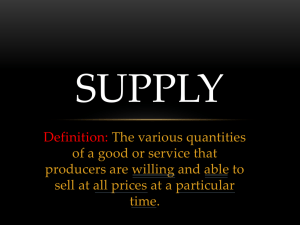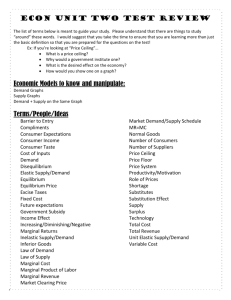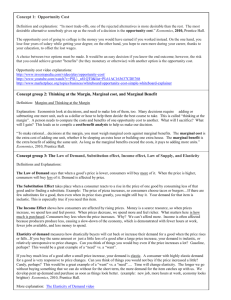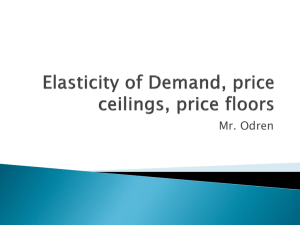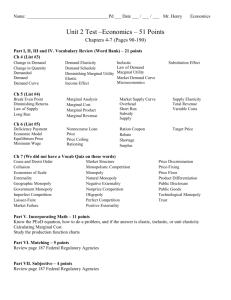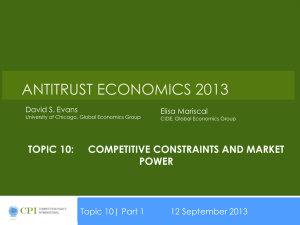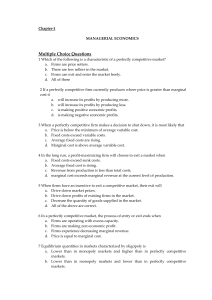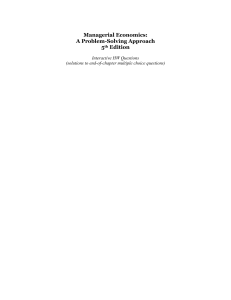Final Exam - Jacob Wall
advertisement
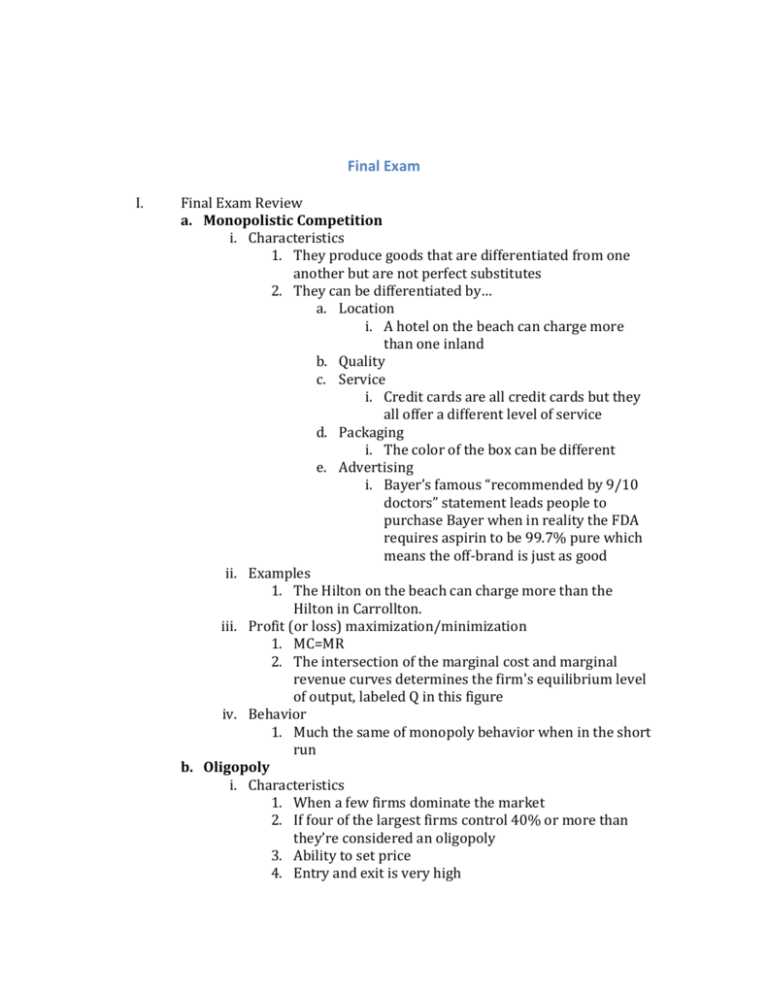
Final Exam I. Final Exam Review a. Monopolistic Competition i. Characteristics 1. They produce goods that are differentiated from one another but are not perfect substitutes 2. They can be differentiated by… a. Location i. A hotel on the beach can charge more than one inland b. Quality c. Service i. Credit cards are all credit cards but they all offer a different level of service d. Packaging i. The color of the box can be different e. Advertising i. Bayer’s famous “recommended by 9/10 doctors” statement leads people to purchase Bayer when in reality the FDA requires aspirin to be 99.7% pure which means the off-brand is just as good ii. Examples 1. The Hilton on the beach can charge more than the Hilton in Carrollton. iii. Profit (or loss) maximization/minimization 1. MC=MR 2. The intersection of the marginal cost and marginal revenue curves determines the firm's equilibrium level of output, labeled Q in this figure iv. Behavior 1. Much the same of monopoly behavior when in the short run b. Oligopoly i. Characteristics 1. When a few firms dominate the market 2. If four of the largest firms control 40% or more than they’re considered an oligopoly 3. Ability to set price 4. Entry and exit is very high 5. Products are either homogenous (steel) or differentiated (automobiles) ii. Examples 1. Network television 2. Beer Industry 3. Airline Industry 4. Auto Industry iii. Profit or loss maximization/minimization 1. MR=MC iv. Behavior (Non collusive & collusive) 1. They have mutual interdependence; actions of one firm influenced by other 2. How do firms react? a. Non-Collusive i. They’re simply competing with one another. Example: Walmart and Target ii. KINKED DEMAND CURVE – REVIEW! 1. Assume price decreases; ignore price increases 2. Firm A – D1 elasticity > D2 (D1 slope more steep) a. D1 - w/e A does, B&C match b. D2 – w/e A does, B&C ignore c. Erase top of D1/MR1 & bottom of D2/MR2 from intersection i. MC can vary anywhere between MR vertical gap; won’t vary airline’s P/Q decision – “sticky prices” iii. Price leadership 1. One firm sets the price and the rest follow b. Collusive i. They are getting together. ii. Violates anti-trust laws iii. Example: Cartels like OPEC v. Herfindahl index 1. Measurement of the size of firms in relation to the industry and an indicator of the amount of competition among them. 2. Sum of the squares of the market shares c. Labor Markets / Resource Markets i. Demand for labor is a DERIVED demand 1. The demand for auto workers is derived from the demand for automobiles 2. How inelastic is labor? a. MRC = W b. Elasticity of Labor = %ΔL/%ΔW c. What effects it’s elasticity? i. Elasticity of Demand for Product (Output) ii. Demand for labor is a derived demand iii. Derived from the output that the labor produces iv. If you increase the price of the product by 10% and the consumption declines 50%(elastic) then labor is reduced sizably. v. If you increase the price of the product by 10% and the consumption declines 2% (Inelastic) then labor is reduced sizably. vi. Labor share of total cost (TC) 1. The higher the share of total cost the more elastic 2. The lesser the share of total cost the more inelastic 3. Example: a. 1 i. Labor represents 20% of total cost ii. Wages go up 20% iii. Total wages become 24% (+4%) b. 2: i. Labor represents 80% of total cost ii. Wages go up 20% iii. Total wages become 96% (+16%) c. You would become more responsive in example 2. vii. # of substitutes 1. The more substitutes the more elastic the demand for the labor. 2. Example: a. ATMs being a substitute for bank tellers (elastic) b. If you’re a heart surgeon there isn’t a substitute so thus they are much more inelastic viii. Time 1. The longer the time period of the consideration the more elastic it becomes ii. Marginal Revenue Product (MRP) 1. The additional revenue the firm gets from hiring one more worker 2. The workers value to the firm 3. Marginal Revenue * Marginal Product iii. Marginal Resource Cost 1. iv. How does a firm find out the profit maximization amount of workers to hire? Assume it’s competitive, what wage rate, what happens when you relax the competitive notion and it becomes a monopsony? How is the wage rate affected? v. What is the unique aspect of land? 1. Fixed in supply 2. Price is demand determined d. Market Failure i. Definition 1. They do not provide the efficient amount, either more or less. ii. Public Goods 1. Why are they a market failure? a. If the total benefit outweighs total cost we should do it b. Log Rolling – Trading of votes for a favorable outcome 2. Characteristics a. Non-rival i. Many people can enjoy the product at one time b. Non-exclusive i. You can not exclude anyone ii. Free-rider problem 3. Examples a. National defense iii. Externalities 1. What is an externality? a. Whenever a third party incurs a cost or receives a benefit of some sort 2. Characteristics a. Spillover benefits i. Positive b. Spillover costs i. Negative 3. Examples a. Positive i. Christmas lights b. Negative i. Farmer ii. Factory iv. Imperfect 1. Why are they a market failure? a. Lack of information can either cause overconsumption or paying too much b. Lemon Problem i. Lemon laws protect consumers (think cars) c. Moral Hazard i. When a part of a contract passes the cost of their behavior onto another party 2. Characteristics a. 3. Examples a. Used car market b. v. Paradox of voting 1. It violates law of transitivity a. It should be A>B; B>C; A>C b. A>B>C>A>B>C>Etc c. Platinum > Gold; Gold>Silver; but if you say silver > Platinum you are getting an inconsistent result. This only applies to voting of public goods. d. Yields inefficient result.




